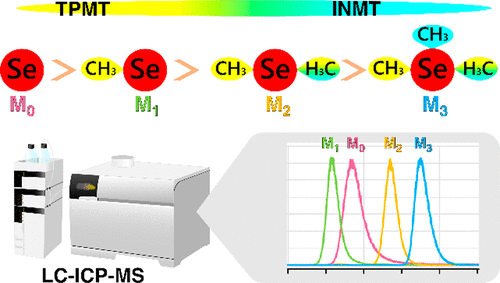当前位置:
X-MOL 学术
›
Chem. Res. Toxicol.
›
论文详情
Our official English website, www.x-mol.net, welcomes your
feedback! (Note: you will need to create a separate account there.)
Production of a Urinary Selenium Metabolite, Trimethylselenonium, by Thiopurine S-Methyltransferase and Indolethylamine N-Methyltransferase.
Chemical Research in Toxicology ( IF 3.7 ) Pub Date : 2020-08-13 , DOI: 10.1021/acs.chemrestox.0c00254 Yasunori Fukumoto 1 , Hirotaka Yamada 1 , Kemmu Matsuhashi 1 , Wakaba Okada 1 , Yu-Ki Tanaka 1 , Noriyuki Suzuki 1 , Yasumitsu Ogra 1
Chemical Research in Toxicology ( IF 3.7 ) Pub Date : 2020-08-13 , DOI: 10.1021/acs.chemrestox.0c00254 Yasunori Fukumoto 1 , Hirotaka Yamada 1 , Kemmu Matsuhashi 1 , Wakaba Okada 1 , Yu-Ki Tanaka 1 , Noriyuki Suzuki 1 , Yasumitsu Ogra 1
Affiliation

|
Selenium (Se) is an essential trace element in animals; however, the element can become highly toxic in excess amounts beyond the nutritional level. Although Se is mainly excreted into urine as a selenosugar within the nutritional level, excess amounts of Se are transformed as an alternative urinary metabolite, trimethylselenonium ion (TMSe). Se methylation appears to be an important metabolic process for the detoxification of excess Se; however, the biochemical mechanisms underlying the Se methylation have not been elucidated. In this study, we evaluated biochemical characteristics of two human methyltransferases for Se methylation, thiopurine S-methyltransferase (TPMT) and indolethylamine N-methyltransferase (INMT). The first methylation of Se, i.e., a nonmethylated to a monomethylated form, was specifically driven by TPMT, and INMT specifically mediated the third methylation, i.e., dimethylated to trimethylated form. The second methylation, i.e., a monomethylated to dimethylated form, was driven by either TPMT or INMT. Exogenous expression of TPMT, but not INMT, ameliorated the cytotoxicity of inorganic nonmethylated selenium salt, suggesting that only TPMT gave the cellular resistance against selenite exposure. TPMT was ubiquitously expressed in most mouse tissues and preferably expressed in the liver and kidneys, while INMT was specifically expressed in the lung and supplementally expressed in the liver and kidneys. Our results revealed that both TPMT and INMT cooperatively contributed to the TMSe production, enabling urinary excretion of Se and maintenance of homeostasis of this essential yet highly toxic trace element. Thus, TPMT and INMT can be recognized as selenium methyltransferases as a synonym.
中文翻译:

通过硫嘌呤 S-甲基转移酶和吲哚乙胺 N-甲基转移酶生产尿硒代谢物三甲基硒。
硒 (Se) 是动物必需的微量元素;然而,超出营养水平的过量元素会变得剧毒。虽然硒主要作为营养水平内的硒糖排泄到尿液中,但过量的硒会转化为替代的尿液代谢物,三甲基硒离子(TMSe)。硒甲基化似乎是多余硒解毒的重要代谢过程。然而,硒甲基化的生化机制尚未阐明。在这项研究中,我们评估了两种人类甲基转移酶 Se 甲基化、硫嘌呤S-甲基转移酶 (TPMT) 和吲哚乙胺N 的生化特征。-甲基转移酶(INMT)。Se 的第一次甲基化,即从非甲基化到单甲基化形式,由 TPMT 特异性驱动,而 INMT 特异性介导第三次甲基化,即从二甲基化到三甲基化形式。第二个甲基化,即从单甲基化到二甲基化的形式,由 TPMT 或 INMT 驱动。TPMT 的外源表达,而不是 INMT,改善了无机非甲基化硒盐的细胞毒性,表明只有 TPMT 赋予细胞抵抗亚硒酸盐暴露的能力。TPMT在大多数小鼠组织中普遍表达,优选在肝脏和肾脏中表达,而INMT在肺中特异性表达,并在肝脏和肾脏中补充表达。我们的结果表明,TPMT 和 INMT 共同促进了 TMSe 的产生,能够通过尿液排出硒并维持这种必需但具有剧毒的微量元素的体内平衡。因此,TPMT和INMT可以被认为是硒甲基转移酶的同义词。
更新日期:2020-09-21
中文翻译:

通过硫嘌呤 S-甲基转移酶和吲哚乙胺 N-甲基转移酶生产尿硒代谢物三甲基硒。
硒 (Se) 是动物必需的微量元素;然而,超出营养水平的过量元素会变得剧毒。虽然硒主要作为营养水平内的硒糖排泄到尿液中,但过量的硒会转化为替代的尿液代谢物,三甲基硒离子(TMSe)。硒甲基化似乎是多余硒解毒的重要代谢过程。然而,硒甲基化的生化机制尚未阐明。在这项研究中,我们评估了两种人类甲基转移酶 Se 甲基化、硫嘌呤S-甲基转移酶 (TPMT) 和吲哚乙胺N 的生化特征。-甲基转移酶(INMT)。Se 的第一次甲基化,即从非甲基化到单甲基化形式,由 TPMT 特异性驱动,而 INMT 特异性介导第三次甲基化,即从二甲基化到三甲基化形式。第二个甲基化,即从单甲基化到二甲基化的形式,由 TPMT 或 INMT 驱动。TPMT 的外源表达,而不是 INMT,改善了无机非甲基化硒盐的细胞毒性,表明只有 TPMT 赋予细胞抵抗亚硒酸盐暴露的能力。TPMT在大多数小鼠组织中普遍表达,优选在肝脏和肾脏中表达,而INMT在肺中特异性表达,并在肝脏和肾脏中补充表达。我们的结果表明,TPMT 和 INMT 共同促进了 TMSe 的产生,能够通过尿液排出硒并维持这种必需但具有剧毒的微量元素的体内平衡。因此,TPMT和INMT可以被认为是硒甲基转移酶的同义词。











































 京公网安备 11010802027423号
京公网安备 11010802027423号